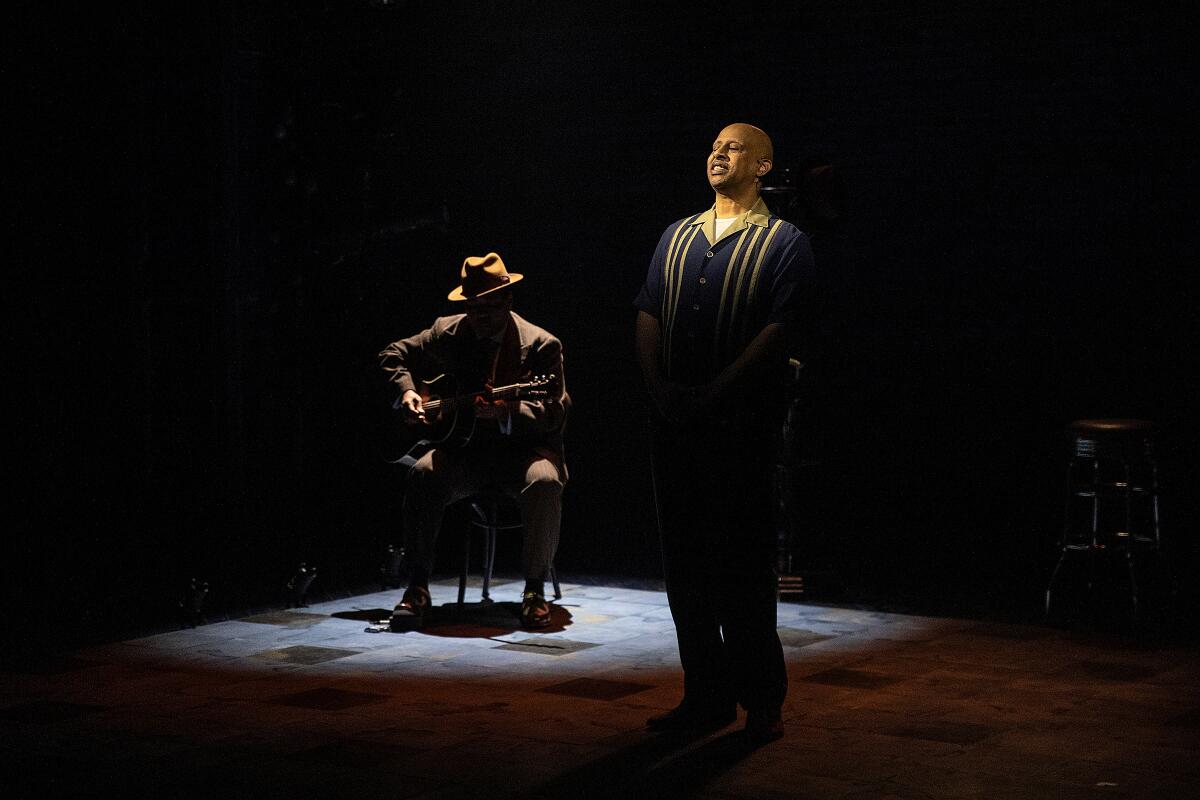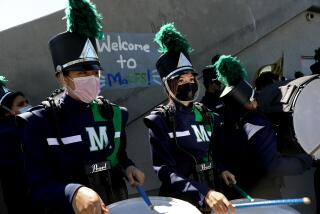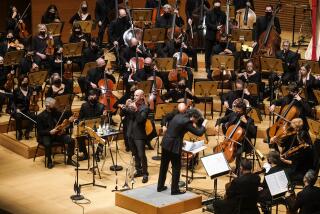Live theater was left out of California’s COVID-19 plan. But now it gets guidelines

- Share via
Live theater in California cannot return indoors until each county in question completely cycles out of the color-coded tiers that serve as a blueprint for reopening, the California Department of Health said Friday.
The department released updated guidelines for live performances that go into effect on April 1 and that stipulate no indoor performances will be allowed as long as the county in question sits in the purple, red, orange or yellow tier. Los Angeles, Orange and San Bernardino counties will move from the purple tier to the red tier by Monday — and will need to see further improvements in COVID-19 case counts and infection rates to progress through orange and yellow.
A county will have to enter the orange tier before live performance can resume outdoors, and at that point audiences will be limited to 20% capacity. When a county enters the yellow tier, capacity increases to 25%.
In both cases, reservations and assigned seating will be required, and attendance will be limited to regional guests coming from within a 120-mile radius.
Prior to Friday, no such guidelines existed, leaving local theater leaders wondering how to plan future programming. The absence of guidelines was particularly challenging for theaters that rely on touring shows booked months in advance.
Sienna Spencer-Markles, a representative for the Los Angeles County Health Department, said by email that the county is relying on the state for guidance on reopenings. She added that county health officer Dr. Muntu Davis said live performance has been discussed but local officials were in a “wait and see” mode because infection and vaccination rates could change state guidance.
Guidelines for live theater stand in stark contrast to the rules for movie theaters. Whereas no live theater in Los Angeles County may operate indoors while the region is in the red tier, indoor movie theaters can operate at 25% capacity or 100 people, whichever is fewer.
“We are both surprised and disappointed to find that the live performing arts continue to be treated so differently from other sectors with similar concerns” said Meghan Pressman, the managing director and chief executive of Center Theatre Group, which closed its Ahmanson Theatre, Mark Taper Forum and Kirk Douglas Theatre exactly one year ago in response to the emerging pandemic. In her emailed response to a Times query Friday, Pressman said it was “distressing that as economic concerns are quoted to advocate for the reopening of other indoor businesses, there is little discussion of the 4.1 million people employed in the arts and culture industry or the $8.7 billion that our sector adds to the GDP.
“We will continue to advocate for the return to our stages as quickly as we can safely do so and feel strongly that there needs to be special consideration for the financial support for the actors, artists, artisans, organizations and others that have dedicated themselves to the arts, who help shape our society and who will clearly be amongst the last allowed to get back to work.”
For now, live performance in Los Angeles County must be staged virtually or as a drive-in, and both approaches present technological and logistical challenges for cash-strapped companies. But the Fountain Theatre in East Hollywood, anticipating the county’s eventual graduation to the orange and yellow tiers, recently announced plans to operate an outdoor stage on its parking lot. The goal is to present the L.A. premiere of “An Octoroon” by Branden Jacobs-Jenkins in June.
The Times has asked state officials if non-permanent venues set up with temporary seating — such as the Fountain’s parking-lot stage — would operate under different capacity guidelines, but officials have not yet responded.
“We’ve been aware that limits on capacity were going to be part of the reopening process, and we have planned accordingly,” said the Fountain’s artistic director, Stephen Sachs, who added that the theater has been in regular conversation with state and county officials, Actors’ Equity Assn. and other L.A. theaters. “We expect the health and safety guidelines to adapt as the COVID numbers continue to go down, month by month. There are still many hurdles to cross, but the overall outlook looks more and more promising and moving in the right direction.”
Being able to stage an outdoor performance for 100 people would still be a substantial improvement and cause for optimism, said Rob Bailis, artistic and executive director of the 500-plus-seat Broad Stage in Santa Monica. Any progress — any change that allows arts groups to rebuild a sense of community — is critically important, he said.
The Broad Stage had projected “small steps to outdoor engagement” with its audience in summer and fall, he said, with hopes that indoor performance might return by the start of 2022. When asked if he was surprised that movie theaters would be reopening but live indoor theater must remain closed, Bailis cited the Broad Stage’s employees who have direct contact with the public — none of whom were categorized as essential workers in the state’s vaccination plans. That, he said, reflected how the arts — “the role we play, the services we provide, the impact we have on our communities” — have been undervalued in the pandemic.
The state guidelines released Friday are just one part of an ever-changing landscape, he said. All arts groups can do is keep trying to move forward, he said. “Stay optimistic and stay focused.”
More to Read
The biggest entertainment stories
Get our big stories about Hollywood, film, television, music, arts, culture and more right in your inbox as soon as they publish.
You may occasionally receive promotional content from the Los Angeles Times.











